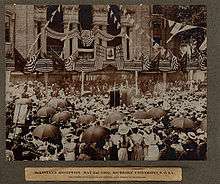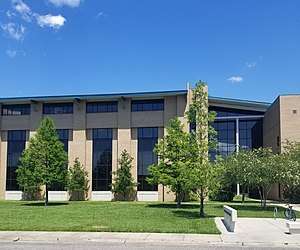Southern University
Southern University and A&M College (Southern University, Southern, SUBR or SU) is a public historically black university (HBCU) in Baton Rouge, Louisiana. It is the largest HBCU in Louisiana, a member-school of the Thurgood Marshall College Fund and the flagship institution of the Southern University System. Its campus encompasses 512 acres, with an agricultural experimental station on an additional 372-acre site, five miles north of the main campus on Scott's Bluff overlooking the Mississippi River in the northern section of Baton Rouge.
 | |
Former names | Southern University for Colored Students |
|---|---|
| Type | Public flagship university HBCU Land grant |
| Established | April 10, 1880 |
Parent institution | SU System |
Academic affiliations | |
| Endowment | $9.4 million (2018)[1] |
| Vice-Chancellor | James H. Ammons |
| President-Chancellor | Ray Belton |
Administrative staff | 1,600 |
| Students | 7,091 (Fall 2019)[2] |
| Location | , , United States 30°31′29″N 91°11′24″W |
| Campus | Urban; 512 acres (207 ha) |
| Newspaper | The Southern Digest |
| Colors | Columbia Blue and Gold[3] |
| Nickname | Jaguars & Lady Jaguars |
Sporting affiliations | NCAA Division I FCS – SWAC |
| Website | www |
 | |
Southern University's 13 intercollegiate athletics teams are known as the Jaguars, and are members of the Southwestern Athletic Conference (SWAC) in NCAA Division I. The Human Jukebox is a well known collegiate marching band that has been representing the university since 1947.
History

At the 1879 Louisiana State Constitutional Convention, African-American political leaders P.B.S. Pinchback, Theophile T. Allain and Henry Demas proposed founding a higher education institution "for the education of persons of color." Louisiana before the American Civil War had an established class of free people of color, who were often property owners and educated; they kept that tradition for their children.
In 1880, the Louisiana General Assembly chartered what was then called Southern University for Colored Students, originally located in New Orleans. Southern opened its doors on March 7, 1881 with 12 students. The school was held for a time at the former Israel Sinai Temple on Calliope Street, between St. Charles and Camp streets.
In 1890, the legislature designated Southern as a land grant college for blacks, in order to continue to satisfy federal requirements under the land grant program to support higher education for all students in the state, despite having a segregated system. It established an Agricultural and Mechanical department.
The 1904 "Picayune Guide to New Orleans" described the University, then on the 5100 block of Magazine Street in Uptown New Orleans, as "for the education of colored persons. Coeducation is in force here. The school is excellent and the instruction of an advanced character." [4]
Because of continued growth and a lack of land for expansion, in 1914 the university moved to Scotlandville, along Scott's Bluff facing the Mississippi River and north of Baton Rouge. Now absorbed into the capital, this area is included as a historic destination of the Louisiana African American Heritage Trail.
The first president of what is now known as Southern University at Baton Rouge was Dr. Joseph Samuel Clark. Clark, an African-American leader from Baton Rouge. He had led Baton Rouge College and the Louisiana Colored Teachers Association.
In 1921, the Louisiana Constitutional Convention authorized the reorganization and expansion of Southern University; Legislative Act 100 of 1922 provided that the institution be reorganized under the control of the State Board of Education. Clark presided over Southern University during its resulting expansion. Student enrollment grew from 47 to 500, and two of the school's early buildings were built during this time.
The Southern University Laboratory School System began operating in September 1922. The Laboratory School was first accredited by the Southern Association of Colleges and Schools in 1936 and has conferred more than 5,000 high school diplomas since its inception.[5] Clark presided until his retirement in 1938.
Clark's son Dr. Felton Grandison Clark was appointed as president that year. He had been serving as a dean at Southern since 1934. The State School for the Negro Deaf and Blind was established here in 1938, under supervision of Southern University. In 1943, the university was visited by the First Lady, Eleanor Roosevelt. F. G. Clark generated much more expansion of the university: 33 of 114 current buildings were erected during his 30 years of tenure. The student enrollment grew from 500 to nearly 10,000 students by the end of his tenure.
Under segregated state education, LSU Law School had refused to admit Charles J. Hatfield, III, an African American college graduate who filed a lawsuit in 1946 to gain professional education in the state. A special Louisiana Convention established a law program in 1947 at Southern University; it is now known as the Southern University Law Center. F. G. Clark expanded affiliated centers for Southern University, founding Southern University at New Orleans (SUNO) (1956) and Southern University at Shreveport (SUSLA) (1964). They were officially incorporated by the legislature into the Southern University System in 1974.
In 1969, Clark retired and Dr. G. Leon Netterville was selected as president. On November 16, 1972, in a second day of protests as students argued to be included in determining administration policies and decisions, Denver Smith and Leonard Brown were shot during a protest outside the Old Auditorium (now the Southern University Museum of Art). The murders have never been solved, but the students were killed with buckshot, which the sheriff's deputies were using. These two students were involved with "Students United," a student activist group. The governor and sheriff's office denied that their people were responsible for the deaths. Governor Edwin Edwards ordered the campus temporarily closed, and it was patrolled by troops to keep the peace.[6]
The institution continued to grow. In 1974, a special session in the Louisiana Legislature established the Southern University System, with Jesse N. Stone of Shreveport as its president. The system consists of Southern University and A&M College, Baton Rouge (SUBR); Southern University, New Orleans (SUNO); Southern University Law Center (SULC); Southern University Agricultural Center (SUAC); and Southern University, Shreveport (SUSLA). SUSLA is a two-year, commuter college.
The Southern University Museum of Art at Shreveport has been designated as a destination of the Louisiana African American Heritage Trail.
In 1978, the legislature merged the Southern School for the Deaf with the Louisiana School for the Deaf, moving the students temporarily into the Mayflower North Campus, during construction of the new South Campus. In 1985, they entered the new buildings in the South.
Between 1970 and 1990, the university consistently enrolled over 10,000 students and secured the title of being the largest HBCU in the nation.[7][8][9]
Between 2004 and 2013, Southern University ranked 4th in the nation for baccalaureate-origin institution of black male doctorate recipients.[10]
Academics
| University rankings | |
|---|---|
| Regional | |
| U.S. News & World Report[11] | 114–142 (South) |
| Master's University class | |
| Washington Monthly[12] | 104 |
There are six degree-granting colleges and a law school on campus:
- College of Education, Arts, and Humanities
- College of Business
- College of Sciences and Engineering
- College of Social and Behavioral Sciences
- College of Sciences and Agriculture
- College of Nursing and Allied Health
- Southern University Law Center
The Southern University Law Center is one of only two public law schools in Louisiana. The law school is accredited by the American Bar Association and was established in 1947. The law school has approximately 700 full-time and part-time students and operates as an independent entity.[13]
Southern University is the first Louisiana institution to offer degrees in philanthropic studies.[14]
In 2018, Southern University's Rehabilitation Counseling master's degree program ranked 58th in the nation according to U.S. News & World Report.[15]
In 2017, the College of Nursing and Allied Health won Louisiana's nursing school of the year award given by the Louisiana Nursing Foundation for the fourth time. The College is the only in Louisiana to offer a PhD in Nursing and is the largest producer of African Americans with Master of Science in Nursing degrees in the nation.[16]
Southern University is the only HBCU and one of six public universities in Louisiana with an engineering program.
Southern University has nationally recognized Army and Navy ROTC programs.[17][18]
The Dolores Spikes Honors College is a selective non degree-granting college specifically established to provide an enhanced educational experience for undergraduates with strong academic achievements and intellectual ability. The college is named after Southern University graduate and only woman president of the institution, Dr. Dolores Richard Spikes.[19]
Southern University and A&M College is accredited by the Southern Association of Colleges and Schools (SACS).
Campus
Lake Kernan flows through the center of the campus and the Mississippi River forms its western boundary. Since 1960, buildings containing more than 2,000,000 square feet of floor area have been constructed.
The notable buildings include:

- John B. Cade Library
- School of Nursing Building
- Valdry Center for Philanthropy
- Health Research Wing of Lee Hall
- Rodney G. Higgins Hall for Social Science
- Augustus C. Blanks Hall for Special Education and Psychology
- Baranco-Hill Student Health Center
- A.A. Lenoir Hall
- College of Engineering Building, P.B.S. Pinchback
- Dolores Spikes Honors College
- T.T Allain College of Business
- Smith-Brown Memorial Union
- J. S. Clark Administration Building
- E. N. Mayberry Dining Hall
- Music Recital Hall
- Isaac Greggs Band Hall
- Southern University Museum of Art
- F. G. Clark Activity Center
- Ace W. Mumford Stadium
- Horace W. Moody Intramural Sports Complex
Southern University has eight on-campus residence halls (4 males only, 2 females only, and 2 co-ed).[20]

The Smith-Brown Memorial Union, a 66,200-square feet multipurpose building which serves as a major center for extracurricular activities. The recently renovated Union features a six food court with popular food outlets; barber and beauty shops; television rooms; 12 bowling lanes; a game room for billiards, video games, and quiet games; an art gallery; a browsing room; a ballroom, meeting and conference rooms; and a U.S. post office. The building also houses offices for student organizations.
The John B. Cade Library is a 154,000 square foot edifice named after the John Brother Cade, the first principal of Southern University Laboratory School. The library contains over a million volumes, nearly 2,000 journal subscriptions, 600,000 microforms and 1,800 recordings. The library houses the Camille Shade African-American Heritage Collection on the 3rd floor.[21][22]
The F.G. Clark Activity Center has accommodations for theater, athletic events, conferences, convocations and recreational activities. The building houses the Athletic Department.
The J.S. Clark Administration Building contains the offices of the Southern University Board of Supervisors, the Southern University System officers, the President-Chancellor of the Baton Rouge campus, and other campus administrative officers.
E.N. Mayberry Dining Hall contains the Magnolia Room, the Cypress Room and the Oak Room, which is for student dining. Dunn Cafeteria is in the Freshman Complex.[23]
Student demographics
As of fall 2015, 65% of students were female and 35% male. 85% of students were from Louisiana; East Baton Rouge Parish, Orleans Parish, and St. Landry Parish were the top three feeder parishes. The top three feeder states for out-of-state students were Texas (244 students), California (71 students), and Georgia (65 students). There were 199 students from a foreign country. Approximately 90% of SU students identified as black and 10% identified as non-black.[24]
Athletics

The Southern Jaguars and Lady Jaguars represent the university in NCAA intercollegiate athletics. Southern's sports teams participate in Division I (FCS for football) in the Southwestern Athletic Conference (SWAC). For more than 20 years, NBC has provided live coverage of Southern University's football game, the Bayou Classic, against its northern Louisiana SWAC rival, Grambling State University.
Southern's other most notable SWAC rivals are Jackson State and Texas Southern.
Student activities
Southern University Marching Band
.jpg)
The Southern University marching band, better known as the Human Jukebox, has been featured in numerous television commercials, music videos and invited to participate in the annual Rose Parade in Pasadena, California, Presidential Inauguration ceremonies and six Super Bowl halftime presentations. The band was also featured in the music videos for the Jonas Brothers song, "Pom Poms" and for Lizzo song, "Good as Hell". In 2008, The band was named "Best Dressed Marching Band" by FashionNews.com, and named "#1 Band In The Nation" by USA Today. In 2014, the NCAA ranked the band second best in the nation.[25] The band is well known for their powerful and dominating sound in the stands, precise, show stopping, high stepping, and entertaining drills on the field, and as being the only HBCU marching band to feature one drum major during performances.
SU media
The university's weekly student produced newspaper is The Southern Digest. The award-winning newspaper was established in 1926 and operates under the Southern University Office of Media Services.[26][27] "The Bluff" is an internet radio station managed by students that offers a mixture of news, interviews, and music.[28]
Student organizations
There are nearly 150 student organizations active on campus. The organizations belong in one of the following categories: Academic, Honors Societies, Multicultural, Non-NPHC Greeks, NPHC Greeks, Political, Professional, Religious, Service, Social, Special Interest, Sports, and School Spirit.[29]
Legacy of Lacumba

Southern University was the first HBCU to house a live mascot on campus. Henry J. Bellaire, alumnus and president of the 1961 senior class, and alumna Helen Williams presented a baby jaguar as a gift to the university. The jaguar was named Lacumba (meaning "Heart of Africa") and was born on May 26, 1971. In 1991, Lacumba retired to the Acadiana Zoo in Broussard, LA and was replaced with Lacumba II. Lacumba II (commonly referred to as simply Lacumba) was born on May 12, 1991, the offspring of two rare black jaguars bred in hopes of producing a black jaguar. However, Lacumba II was born brown; it grew to be 200 pounds. Lacumba II died of natural causes at the age of 15 in December 2004 and was the last jaguar to live on campus. Animal rights advocates dissuaded the university from purchasing a new jaguar. The jaguar pen remains in front of the A.W. Mumford football stadium off Harding Boulevard. The legacy of Lacumba lives on through the school's costumed jaguar mascot.[30][31]
Notable people
Alumni
Faculty
- John Michael Guidry, circuit court judge and Southern faculty member
- Blyden Jackson, English professor from 1954 to 1956, and Dean of the Graduate School.[32]
- Jewel Prestage, Dean of the School of Public Policy and Urban Affairs
- Morgan Watson Engineer
References
- https://www.usnews.com/best-colleges/southern-university-9636
- https://www.wafb.com/2019/09/27/enrollment-su-now-over-students-leaders-hope-have-k-by/
- Southern University Style Guide (PDF). Retrieved December 27, 2017.
- "The Picayune's Guide to New Orleans". The Picayune. November 30, 1904 – via Google Books.
- "Archived copy". Archived from the original on July 5, 2015. Retrieved August 30, 2015.CS1 maint: archived copy as title (link)
- "November 16, 1972: The Southern University Massacre Occurs", Black Then website, 2017
- jbergeron@theadvocate.com, JUDY BERGERON. "Deadly 1972 protest at Southern University highlighted in new PBS documentary on HBCUs".
- "Southern University ][Baton Rouge] (1880- ) - The Black Past: Remembered and Reclaimed". www.blackpast.org.
- "Southern University sees a rise in enrollment numbers".
- "Morehouse facts 2014" (PDF). Morehouse.edu. Retrieved May 26, 2017.
- "Best Colleges 2020: Regional Universities Rankings". U.S. News & World Report. Retrieved September 8, 2019.
- "2019 Rankings -- Masters Universities". Washington Monthly. Retrieved September 8, 2019.
- "Archived copy". Archived from the original on April 26, 2016. Retrieved April 10, 2016.CS1 maint: archived copy as title (link)
- "SUBR will soon offer degrees in Philanthropy: The Valdry Center Unveils".
- "U.S. News Best Grad School Rankings". Usnews.com. Retrieved October 13, 2017.
- "SU nursing grad program named 'School of the Year' | Southern University and A&M College". Subr.edu. June 1, 2017. Retrieved December 26, 2015.
- "Red Stick Battalion - Southern University and A&M College". Subr.edu. Retrieved May 26, 2017.
- "Army ROTC - Southern University and A&M College". Subr.edu. Retrieved May 26, 2017.
- "Honors College - Southern University and A&M College". Subr.edu. Retrieved May 26, 2017.
- "Room Rates - Southern University and A&M College". Subr.edu. Retrieved May 26, 2017.
- "Archived copy" (PDF). Archived from the original (PDF) on December 27, 2015. Retrieved October 12, 2015.CS1 maint: archived copy as title (link)
- "JBCL - Camille Shade/ Black Heritage Collection". Lib.subr.edu. February 8, 1995. Retrieved December 26, 2015.
- "Archived copy" (PDF). Archived from the original (PDF) on May 27, 2010. Retrieved November 4, 2011.CS1 maint: archived copy as title (link)
- "SUBR Fact Book 2012-2013" (PDF). Retrieved May 26, 2017.
- Quincy Hodges, NOLA.com (January 7, 2014). "NCAA ranks Southern's 'Human Jukebox' marching band second in nation". The Times-Picayune. NOLA.com. Retrieved December 26, 2015.
- "The Sentinel of an Enlightened Student Body Since 1926". The Southern Digest. Retrieved December 26, 2015.
- "The Southern Digest wins Louisiana Press Association awards | Southern University and A&M College". Subr.edu. January 5, 2013. Retrieved December 26, 2015.
- "THE BLUFF - Southern University Web Radio". Subr.edu. Archived from the original on March 4, 2016. Retrieved December 26, 2015.
- "Student Organizations & Campus Involvement - Southern University and A&M College". Subr.edu. Retrieved May 26, 2017.
- "Lacumba :: Southern University and A&M College". Contentdm.auctr.edu. Retrieved December 26, 2015.
- "Lacumba Speaks - Southern University and A&M College". Subr.edu. Retrieved May 26, 2017.
- Miller, R. Baxter (Fall 1984). "The Wasteland and the Flower: Through Blyden Jackson: A Revised Theory for Black Southern Literature". The Southern Literary Journal. 17 (1): 3–11. JSTOR 20077746.
External links
| Wikimedia Commons has media related to Category:Southern University. |